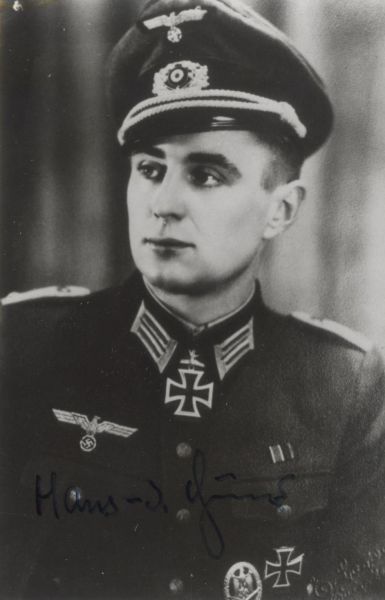Hunger, Hans-Joachim
- Date of birth:
- March 8th, 1921 (Königsberg (East Prussia), Germany)
- Date of death:
- October 4th, 2007 (Itzehoe, Germany)
- Nationality:
- German
Biography
Do you have more information about this person? Inform us!
- Period:
- Second World War (1939-1945)
- Rank:
- Leutnant der Reserve (2nd Lieutenant of Reserves)
- Unit:
- Batterie-Offizier, schwere Artillerie-Abteilung 526 (motorisiert), Heer
- Awarded on:
- April 9th, 1944
“It was in the great March battle in the battle area northwest of Newel. For days the dominant Hill 173.1 was the centre of particularly violent attacks by the enemy, who wanted above all to eliminate a forward observation post that was blocking all Soviet movements through its directed fire.
Thus, on the morning of the 10.03.1944, a heavy barrage preceded another major attack. The forward observer, Leutnant Hunger, left his battery to take on this role in the morning after the unit at Hill 173.1 reported that the original FO, a Wachtmeister, had fallen due to a major shell splinter wound.
Leutnant Hunger immediately began to move out with the Hauptwachtmeister of the Batterie, making swift bounds through the dense enemy blocking fire and eventually making his way there safely. The Hauptwachtmeister and another man carried their heavily wounded comrade on a ripped-out bunker door with evasive detours over a distance of 4 km through this murderous fire zone.
The Leutnant took over the fire control of his and the neighbouring batteries when, at about noon, the enemy’s guns fell silent. In the face of the massed infantry attacks which followed, the friendly Grenadiers were forced to yield their smashed up strongpoints to the enemy and retreat to a fallback position just behind Hill 173.1. This would result in the observation post atop the hill becoming isolated.
The hill, now right in the middle of the enemy onslaught, was still occupied by 10 men as the enemy pushed forward from the front and along the sides with 2 battalions. The mission was to hold the hill for as long as possible which, in this case, meant to the last round. Available weapons included a few rifles and sub-machine guns, as well as some abandoned hand grenades, but practically speaking there was almost nothing but close-combat weapons. However this was of course supported by a ring of concentric fire which the Leutnant placed on the base of the hill. At the same time he also directed the fire support for the left neighbour, Hauptmann Thulke, who would later receive the Oakleaves for holding his position here.
The enemy made persistent attacks from a starting position about 100 m away from makeshift cover, but were repeatedly held back by the wall of fire directed by Leutnant Hunger. And wherever this barrier was penetrated by individual soldiers or small groups, they came under deadly fire from the handful of infantry weapons available. The dead and wounded on the hillsides became ever more numerous. But still more numerous were the reserves which the enemy dispatched again and again. As such they were able to gradually come closer, partially using the cover of their own dead. Finally, the Leutnant had to issue firing orders for artillery shells to rain down just a hair’s breadth from their own position. As a result the oncoming enemy was unable to make any progress through the explosions of snow and shell splinters that erupted all around.
In this inferno of exploding fire and iron, this handful of men managed to hold on to their tiny perimeter until dusk, drawing all the attention of the broken-in enemy onto themselves as a man would gather the spearheads of an enemy phalanx with both arms and steer them into his chest. That said there could be little doubt that the onset of darkness would bring the end for them.
As the evening wore on the enemy sent in tanks, which rolled up the slope to finally overrun and crush the tiny resistance nest. However at the last minute two friendly Sturmgeschütze were brought up, and these destroyed the enemy tanks. In their wake the German infantry finally came forth at the same time and threw the battered enemy from the hill.
The 10 men all received the Iron Cross First Class. The exemplary performance of Leutnant Hunger was honoured with the Knight's Cross. The commanding General of an Armee-Korps handed it over to the young officer alongside a thundering salvo of honour from his Batterie."
- Period:
- Second World War (1939-1945)
- Period:
- Second World War (1939-1945)
- Period:
- Second World War (1939-1945)
Sources
- Photo 1: Willi Schumacher
- - FELLGIEBEL, W.P., Elite of theThird Reich, Helion & Company Limited, Solihull, 2003.
- ritterkreuztraeger-1939-45.de






